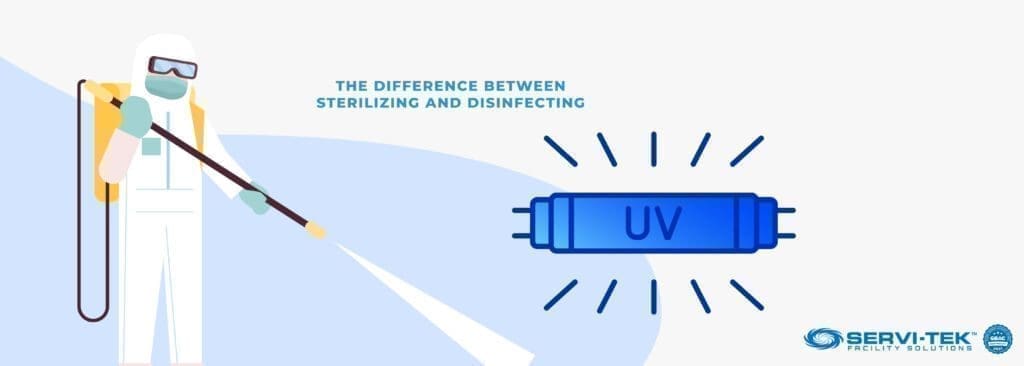
When it comes to infection control, the terms cleaning, disinfection, and sterilization are frequently used. Unfortunately, there is a lot of misunderstanding about which procedures to use and when.
Decontamination is the process of making something safe to touch and includes both disinfecting and sterilizing.
The goal is to eliminate enough bacteria to reduce the risk of illness to a minimum.
Keep reading to learn more about the difference between disinfecting and sterilizing, as well as some recommended practices for combating COVID-19 and other dangerous microorganisms on your commercial premises.
The Difference Between Sterilizing and Disinfecting
It is an important first step to understanding the main difference between the two. Let’s start by knowing what each term means.
Disinfection
The process of destroying unsanitary forms of microorganisms is known as disinfection.
However, the procedure is insufficient to prevent the overgrowth of spores and bacteria, which can survive, infecting items and any area they reach.
For the disinfection process to be effective, you have to clean the dirty surfaces first.
All dirt, dust, and any organic matter must be removed through physical methods, with a cloth, otherwise, the disinfection process won’t be effective.
It is the main takeaway you should keep in mind if you want to drastically reduce the number of germs and the level of microbial contamination in your facility.
Disinfectants are divided into two categories:
1. Broad-spectrum
A broad-spectrum type of disinfectant can be used to kill a large number of disease-causing pathogens. For a commercial setting, the disinfectants used must be approved by EPA and follow all regulations.
2. Narrow spectrum
Narrow spectrum disinfectants are those that can be used to treat a small number of infections and are simple to use, non-toxic, and relatively inexpensive.
One of the advantages of disinfection is the wide range of products available to the general population.
Depending on the disinfectant, it may be necessary to leave the product on surfaces for shorter exposure periods, or as long as 12 hours, according to the CDC guidelines.
Types of disinfection

The most common types of disinfection methods include:
Air disinfectants
Disinfectant droplets are vaporized in the air at a high enough concentration to minimize the number of microorganisms.
Aldehydes
These substances are most effective against spores and fungi.
Oxidizing agents
Because chlorine and oxygen are powerful oxidizers, their compounds are generally utilized, the most common example being the classic bleach.
It is the most cost-effective household disinfectant for cleaning toilets, swimming pools, drains, and other objects and surfaces.
Alcohol
It has a high concentration and can effectively inactivate viruses including HIV, hepatitis B, and hepatitis C. Ethanol or isopropanol are the basic ingredients. It is one of the most common methods used in the decontamination process.
The liquid chemicals included are both safe and economical to employ in a domestic setting and are available to the general public.
UV lights
Microorganisms are often killed by UV radiation on hard surfaces. UVC lamps, on the other hand, can be used to disinfect air and water. It’s especially good in stopping the spread of infection.
Sterilization
All biological pathogens are killed during sterilization.
More specifically, sterilization eliminates harmful microorganisms such as fungi, bacteria, viruses, microbes, and spores – basically any form of forms of microbial life that is found in places such as a surface or fluids.
Sterilization is accomplished through the use of certain solutions or, in some cases, exposure to physical and chemical agents, as well as filtration.
Sterilization is most commonly used in healthcare, veterinary, and hospital settings, where it is critical to eliminate resistant germs.
Because medical equipment is used by many with various types of procedures it is critical to fully sterilize everything.
Types of Sterilization

Steam
Steam is used in autoclaves, which are heated to 121–134 °C. All microorganisms are destroyed, including fungus, bacteria, viruses, and bacterial spores.
Heating
Dry heat and moist heat are the physical ways of sterilization.
Dry heat sterilizing occurs at a high temperature in the absence of moisture, whereas moist heat sterilization occurs at a high temperature and pressure caused by steam.
These techniques aid in destroying microorganisms in materials such as glass and metals.
Sterilization by radiation
Radiation sterilization is used for sterilizing disposable medical equipment – for example, syringes and needles.
This approach uses electron beams, X-rays, gamma rays, or subatomic particles.
Filtration
Clear liquids that would be harmed by heat, irradiation, or chemical sterilization are sterilized using this procedure.
Sterilization with chemical solutions
Ethylene oxide, ozone, Chlorine Bleach, Hydrogen Peroxide, and Peracetic acid among others are utilized in variable degrees in this chemical process and are extremely effective because they destroy the nucleic acid of any emerging pathogen.
Similarities Between Sterilization and Disinfection
In comparison, there are many significant differences between the two methods, but there are also similarities.
They’re both used to disinfect objects and clean surfaces, for example. Both techniques are capable to kill germs and destroy the majority of dangerous microorganisms.
They are best used together in various areas – a great example is the health care industry, to prepare for medical procedures, and to keep at bay any dangerous viruses.
Areas of use for sterilization and disinfection

What areas should be disinfected?
Varied places within your building will have different protocols for whether they should be sterilized or disinfected, depending on your facility and industry.
Clean-up and disinfection methods should be discussed with your commercial services provider.
It is important to focus on high-touch locations regularly.
These generally include surfaces in common areas such as:
- Doorknobs
- Handrails
- Light switches
- Soap dispensers
- Handles
- Electronic devices
What areas should be sterilized?
Due to its benefits, sterilization is mostly used in medical facilities and any healthcare setting, but it doesn’t stop here and its effects can be seen in various industries.
Medical devices that come in contact with skin, blood, or fluids are on the top of the list for sterilization.
Because any microbiological contamination could result in disease transmission, these things should be used sterile.
Surgical instruments, biopsy forceps, and implanted medical gadgets are examples of such devices. If these products are heat resistant, steam sterilization is advised since it offers the highest margin of safety because of its uniformity and reliability.
The benefits of disinfection and sterilization methods

Commercial cleaning specialists, whether new to the field or seasoned veterans, understand the necessity of keeping a clean and safe environment.
Here are the main benefits of high-level disinfection and sterilization processes in your commercial property:
1. A safe workplace
If you don’t have cleaning professionals watching out for spills, clogs, and build-ups in your facility, you’re putting your employees’ safety at risk.
A full-time team of cleaners is the best way to maintain your workplace. The link between cleaning and safety extends far beyond spills and slips.
Different procedures and different products are used based on the needs of your staff and building to ensure a safe, healthy, and germ-free environment.
2. Healthy employees and clients
In an office setting, school, or a hospital, people have a place to rest, prepare and consume meals and use a restroom.
Unfortunately, all of these different areas are magnets for germs and bacteria, and if one person gets sick, you can bet that by the end of the week, half of your staff will be complaining of the same symptoms.
This is where the correct process of disinfection, and/or, depending on the case, the sterilization process, plays a major role in stopping the growth of microorganisms.
Steam cleaning and sanitizing these surfaces decreases the spread of germs in your workplace and guarantees that your facilities are clean and safe to work in.
Businesses should also choose the correct hand sanitizer, understand where, how, and how often to use it, and how frequently personnel must wash their hands.
3. Saves you time and money
As a facility manager in the United States, let’s face it – if you don’t have an expert to guide you, cleaning will fall on you and your employees.
Non-professionals using just a mop and bucket will do a poor job that will leave behind
pathogenic microorganisms and bring more harmful effects than you can imagine.
If you don’t have cleaning professionals to watch out for spills, maintain a sterile environment when needed, and use different methods to tackle other issues on your commercial property, you’re putting your employees’ safety at risk.
4. A plan made for your needs
The purpose of a commercial disinfection and sterilization company is to meet and exceed your expectations, therefore their services are tailored to your company’s needs.
They will meet with you and walk you through the different ways in which they can help, discuss your objectives and advise on the best practices for your facility.
Work with an industry leader
It’s a good idea to consult specialists in the field of disinfection and sterilization when deciding how to efficiently stop the growth of bacteria and the spread of infectious diseases in your facility.
Why do it yourself and worry about whether you’re doing everything you can to protect your employees and customers?
At Servi-Tek, our team of professionals is specially trained to establish and maintain proper protocols and have access to the best products, equipment, application methods, and different processes and know how to get the job done.
Allow us to handle the details while you focus on your core business. Give us a call today to learn more!




